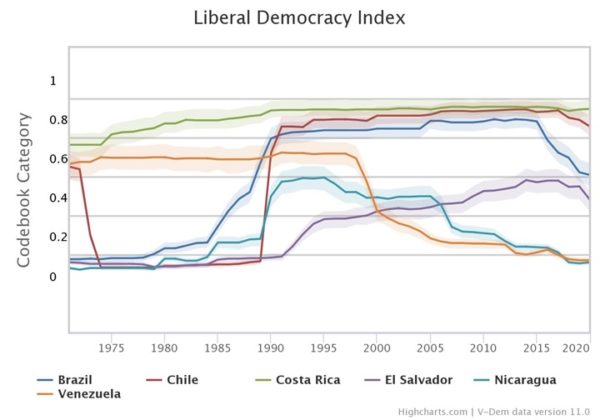Authoritarian Waves in Latin America: Back to the Past?
By Armando Chaguaceda
HAVANA TIMES – Peru was recently in the spotlight because of its general elections. The tight race between Leftist candidate Pedro Castillo and his right-wing opponent Keiko Fujimori reflected an internal polarization, which was soon displaced to their international allies. Both the Lefts (democratic or populist) as well as their Right counterparts (moderate or extreme) took sides with their local parties. The interesting thing about this though, beyond ideological cleavages, is the similarities in both campaigns. As well as the footprints they project on Peru’s and Latin America’s political course.
Castillo and Fujimori both defend conservative agendas in terms of recognizing human rights and respect for diverse identities. Their government projects promote clear focuses (a statist one on the one hand and neoliberal one on the other) on economic development and public administration. Their political models reveal a structural tension with any sustainable vision of a democratic republic. I’m afraid that the hangover from these elections will extend beyond the temporary and, worse yet, national borders.
Let’s examine what’s happened in the past 35 years. Democracies were reinstated in Latin America that did not come about from the construction of inclusive Welfare States. Social and economic inequalities remained in place and became starker with neoliberal policies.
In spite of this, citizens slowly regained their ability to exercise their rights, which had been both affected by authoritarianism’s legacy as well as the neoliberal model. Strong human rights advocate communities and NGO networks were created, to improve civic culture and to make demands to the governments on behalf of the socially marginalized. Democratic regimes became the formal framework of politics in most of the Americas.
Nevertheless, after decades of imperfect but real democratic recovery, Latin America’s main agents (the elite, parties, movements) have shown a weak republican commitment. By insisting on discriminatory socioeconomic models, the Right has stopped inclusive Welfare States from being built with authentic social citizenship. While the Left has often promised social inclusion at the expense of civic freedoms and political pluralism.
In Latin America. preexisting social polarizations (of race, class and region) have been reinforced by induced political polarization, in the mobilizing strategy of both radical governments and opposition. The gradual improvement in democratic indicators in recent decades is now under threat – and in some cases reversed – by authoritarian trends in recent years, under governments of different ideological stripes. Which can be clearly seen in the following graph, a synthesis of data taken from the international cooperation project V-Dem and its study on democracies:

History has taught us that this isn’t anything new. Political expert Kurt Weyland explained[i] how the world experienced the worst democratic setback in the modern history of Europe and Latin America. In the 1920s and 1930s, Bolshevik radicalization gave birth to extreme Right movements. Fears of Communism (which stemmed from right-wing preconceptions as much as they did from Soviet authoritarian praxis) cast doubts upon Democracy’s survival and laid the way for Mussolini’s rise to power in Italy and Hitler’s rise to power in Germany. The political center (socialist or liberal, Christian or popular) was debilitated or annihilated under both Facist totalitarianism and conservative authoritarianism in many countries.
In Latin America, the spiral of ideological radicalization, political polarization and all kinds of autocracies, gained steam thirty years later, after the Cuban Revolution triumphed in 1959. The Latin American Left believed that they could import the Castro script into their own countries. Rightists then confused any progressive demand with the threat of Communism. As Weyland explains in another book[ii], radicalized ideas, over-the-top expectations and the predictions of biased interest led to the horrors that took place in the 1960s, ‘70s and ‘80s. Millions of Latin Americans, including the creme de la creme of its youth, perished in civil wars and at the hands of repression under the mantra of revolution and the fight against subversion.
So, military regimes, instated with the CIA’s blessing and support from the elite and most of the middle class, brutally repressed the Left. The ironic result was that now this autocracy agenda was being implemented from the opposite side of the political spectrum. Cuba, Nicaragua and Venezuela are its most extreme expressions, with the complicity of the moderate Left. Taking into account the double standard in the way the progressive intellectuals condemn Duque or Piñera in Colombia and Chile, while praising (or keeping quiet about) Diaz Canel or Maduro, is enough to understand this.
The current situation of Leftist autocracies (which have established themselves in democracies and are disastrous in their own terms) could anticipate a new spiral of dictatorial responses from the right-wing opposition, such as those represented by Bolsonaro (Brazil), Uribe (Colombia) or the even more enigmatic Bukele (El Salvador). If the latter are able to solidify their mutation of leaderships and movements into tout court authoritarian regimes, Lain America will see its worst demons arise again. The continent is divided into two authoritarian blocks, with opposing ideologies, with some disjointed islets of political freedom. While bleak, this reality is becoming a more and more prospective landscape for upcoming years.
[i] Assault on Democracy: Communism, Fascism, and Authoritarianism During the Interwar Years, Cambridge University Press, 2021.
[ii] Revolution and Reaction: The Diffusion of Authoritarianism in Latin America, Cambridge University Press, 2019.






Democracy in Latin America? When? Where? Each country has gone from dictadura to “dictablanda” or from “dictablanda” to dictadura. It is the history of countries that were colonized by Spain or by Portugal. Democracy does not seem to survive anywhere in Latin America. It’s in the continent’s DNA.
“The continent is divided into two authoritarian blocks”
No Brazil and Colombia have real elections parties and leaders come and go.
Cuba, Venezuela and Nicaragua are tyrannies. The opposition goes to prison or flees for their life.